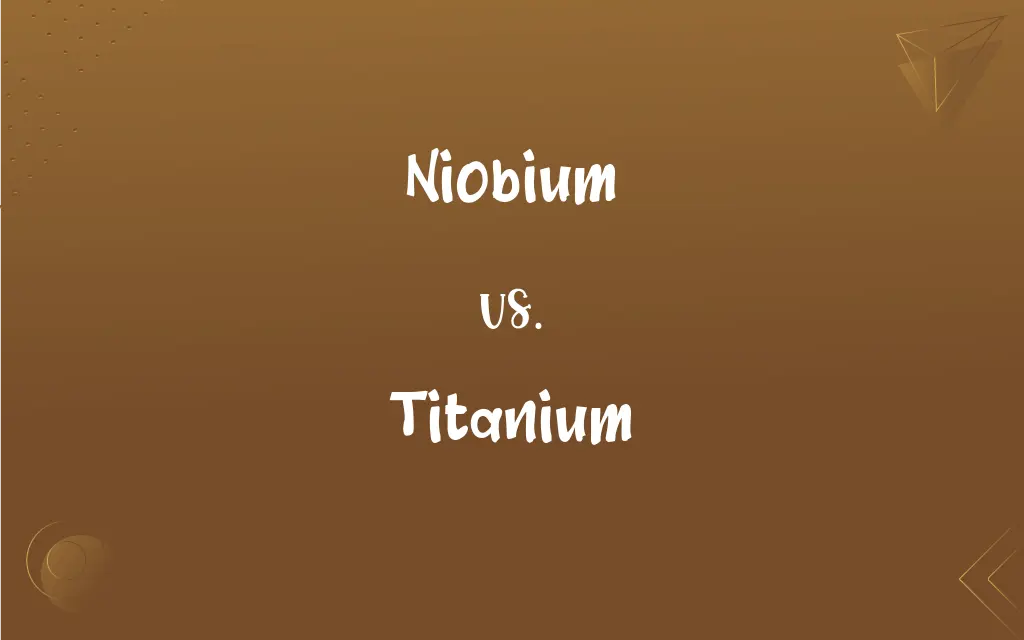Niobium vs. Titanium: What's the Difference?
Edited by Aimie Carlson || By Harlon Moss || Published on February 2, 2024
Niobium is a soft, grey, ductile transition metal, often used in steel alloys, while titanium is a strong, lightweight metal known for its corrosion resistance and use in aerospace.

Key Differences
Niobium is a chemical element with the symbol Nb and atomic number 41. It's a soft, ductile metal, primarily used in alloys to improve strength, particularly in steel. Titanium, with the symbol Ti and atomic number 22, is renowned for its strength-to-weight ratio, corrosion resistance, and is widely used in aerospace, medical implants, and jewelry.
In terms of abundance, niobium is less common in the Earth's crust compared to titanium. Titanium is the ninth most abundant element in the Earth’s crust and is found in almost all rocks and sediments.
Niobium’s melting point is 2,468°C, which is lower than titanium's melting point of 1,668°C. This makes niobium less suitable for high-temperature applications where titanium excels.
Niobium is often used in superconducting magnets due to its excellent superconducting properties, whereas titanium is preferred in aerospace and biomedical applications for its strength, lightweight, and biocompatibility.
The two metals also differ in their reaction to oxygen. Niobium forms a thin oxide layer when exposed to air at room temperature, while titanium forms a more resilient oxide layer, enhancing its corrosion resistance.
ADVERTISEMENT
Comparison Chart
Chemical Symbol
Nb
Ti
Atomic Number
41
22
Primary Use
Steel alloys, superconductors
Aerospace, medical implants, jewelry
Abundance
Less common in Earth's crust
Ninth most abundant element in Earth's crust
Melting Point
2,468°C
1,668°C
ADVERTISEMENT
Key Properties
Soft, ductile, good superconductor
Strong, lightweight, corrosion-resistant
Niobium and Titanium Definitions
Niobium
Niobium is a soft, grey metal.
Niobium's softness makes it easy to alloy with other metals.
Titanium
Titanium is a strong, lightweight metal.
Titanium's strength and lightness make it ideal for aerospace components.
Niobium
It has superconducting properties.
Niobium's use in superconducting magnets is critical for MRI machines.
Titanium
Titanium is used in medical implants.
Titanium implants are widely used due to their biocompatibility.
Niobium
It is used to strengthen steel.
Adding niobium to steel improves its strength and durability.
Titanium
It has a high melting point.
Titanium's high melting point makes it suitable for high-temperature environments.
Niobium
Niobium is a transition metal.
As a transition metal, niobium exhibits versatile chemical properties.
Titanium
Titanium is abundant in the Earth's crust.
The abundance of titanium makes it readily available for various industries.
Niobium
Niobium forms an oxide layer in air.
The oxide layer on niobium helps protect it from corrosion.
Titanium
It is highly corrosion-resistant.
Titanium's resistance to corrosion is beneficial for marine applications.
Niobium
A silvery, soft, rare, ductile metallic element that occurs chiefly in columbite-tantalite and is used in steel alloys, arc welding, and superconductive materials. Atomic number 41; atomic weight 92.906; melting point 2,477°C; boiling point 4,744°C; specific gravity 8.57; valence 2, 3, 5. See Periodic Table.
Titanium
A strong, low-density, highly corrosion-resistant, lustrous white metallic element that occurs widely in igneous rocks and is used to alloy aircraft metals for low weight, strength, and high-temperature stability. Atomic number 22; atomic weight 47.87; melting point 1,668°C; boiling point 3,287°C; specific gravity 4.51; valence 2, 3, 4. See Periodic Table.
Niobium
A chemical element (symbol Nb) with an atomic number of 41: a light grey, crystalline, ductile transition metal used in superconducting materials.
Titanium
A chemical element, atomic number 22; it is a strong, corrosion-resistant transition metal, used to make light alloys for aircraft etc.
Niobium
(countable) A single atom of this element.
Titanium
(countable) A single atom of this element.
Niobium
The chemical element of atomic number 41. Chemical symbol Nb. Atomic weight 92.91. Previously called columbium. See also Columbium.
Titanium
An elementary substance found combined in the minerals manaccanite, rutile, sphene, etc., and isolated as an infusible iron-gray amorphous powder, having a metallic luster. It burns when heated in the air. Symbol Ti. Atomic weight 48.1.
Niobium
A soft gray ductile metallic element used in alloys; occurs in niobite; formerly called columbium
Titanium
A light strong gray lustrous corrosion-resistant metallic element used in strong light-weight alloys (as for airplane parts); the main sources are rutile and ilmenite
FAQs
What are the main applications of titanium?
Titanium is mainly used in aerospace, medical implants, and jewelry.
Is niobium a rare metal?
Niobium is less common than titanium but is not considered rare.
What is niobium primarily used for?
Niobium is primarily used in steel alloys and superconductors.
Can titanium be used in the human body?
Yes, its biocompatibility makes it suitable for medical implants.
What is the melting point of niobium?
Niobium has a melting point of 2,468°C.
How is titanium extracted?
Titanium is typically extracted from ilmenite and rutile minerals.
Why is titanium resistant to corrosion?
Titanium forms a stable oxide layer that protects it from corrosion.
How does niobium react to oxygen?
Niobium forms a thin oxide layer when exposed to air.
Why is titanium favored in aerospace?
Its strength-to-weight ratio and corrosion resistance make it ideal for aerospace applications.
How does the weight of titanium compare to other metals?
Titanium is lighter than many metals, including steel.
What is the atomic number of titanium?
The atomic number of titanium is 22.
How is niobium extracted?
Niobium is extracted from niobium-rich minerals like pyrochlore.
Are niobium and titanium similar in strength?
Titanium is generally stronger and more durable than niobium.
Is titanium a good conductor of electricity?
Titanium is not a particularly good conductor of electricity.
Can niobium be used in jewelry?
Yes, niobium is used in jewelry, often anodized for different colors.
What is the atomic number of niobium?
The atomic number of niobium is 41.
Where is niobium commonly found?
Niobium is commonly found in pyrochlore and columbite minerals.
Can niobium be alloyed with other metals?
Yes, niobium is often alloyed with steel and other metals.
What are the environmental impacts of niobium mining?
Niobium mining can impact the environment, necessitating responsible mining practices.
How does titanium react with air?
Titanium reacts with air to form a protective oxide layer.
About Author
Written by
Harlon MossHarlon is a seasoned quality moderator and accomplished content writer for Difference Wiki. An alumnus of the prestigious University of California, he earned his degree in Computer Science. Leveraging his academic background, Harlon brings a meticulous and informed perspective to his work, ensuring content accuracy and excellence.
Edited by
Aimie CarlsonAimie Carlson, holding a master's degree in English literature, is a fervent English language enthusiast. She lends her writing talents to Difference Wiki, a prominent website that specializes in comparisons, offering readers insightful analyses that both captivate and inform.






































































